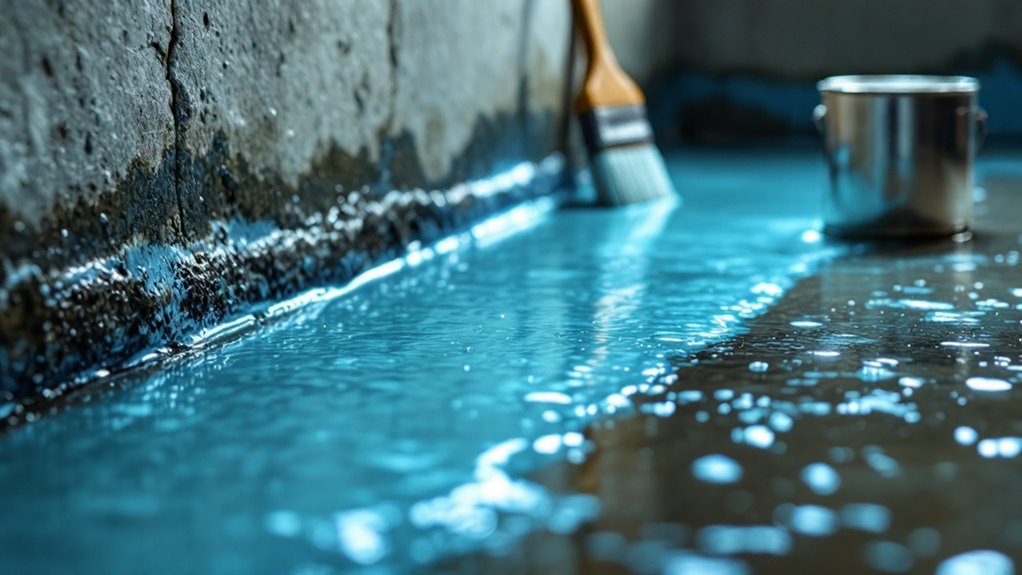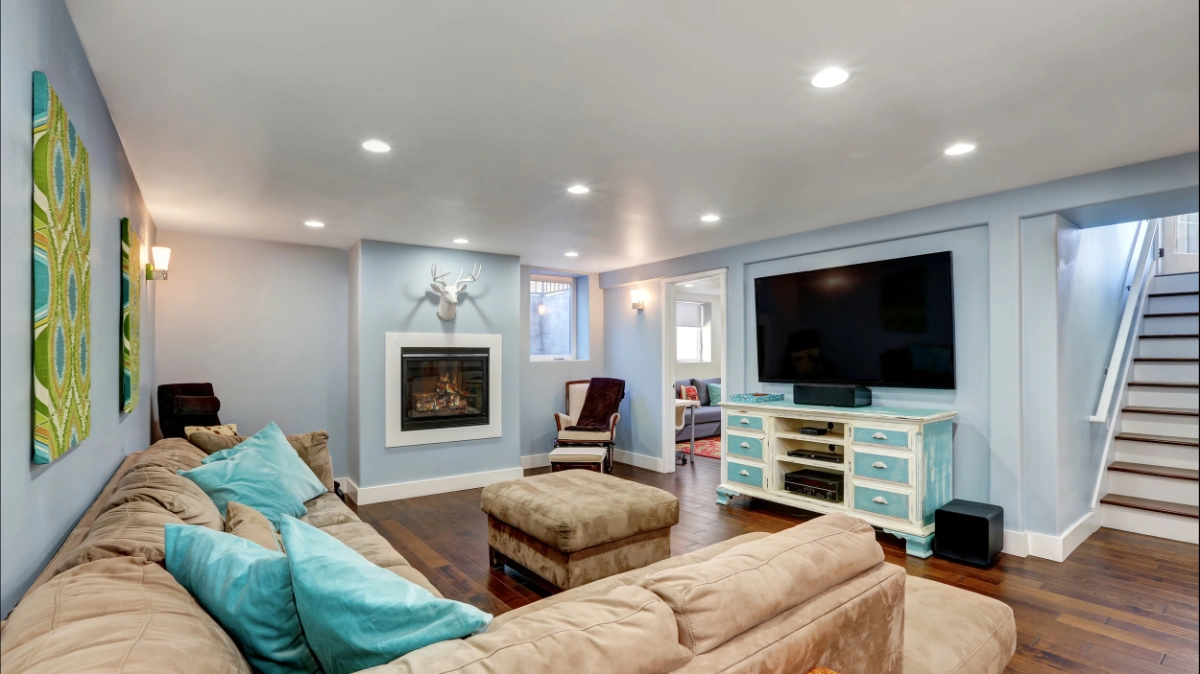The cheapest basement waterproofing method typically includes using waterproof paint or crack injections. These options range from $1 to $2 per square foot and provide effective moisture barriers.
DIY drainage systems like French drains can also be cost-effective. While interior solutions like sealants are budget-friendly, they may not solve underlying issues.
To choose the best solution for your situation, let’s explore the various options and their effectiveness.
Key Takeaways
- Waterproof sealants are a budget-friendly option for surface protection against moisture.
- Crack injection is an affordable method to effectively seal small-to-medium cracks and prevent seepage.
- DIY drainage systems, like French drains, offer cost-effective solutions for managing water outside the home.
- Interior waterproof paints are easy to apply and provide a moisture barrier at a low cost.
- Simple preventative measures, such as cleaning gutters and extending downspouts, can significantly reduce water-related issues.
Basic Waterproofing Methods
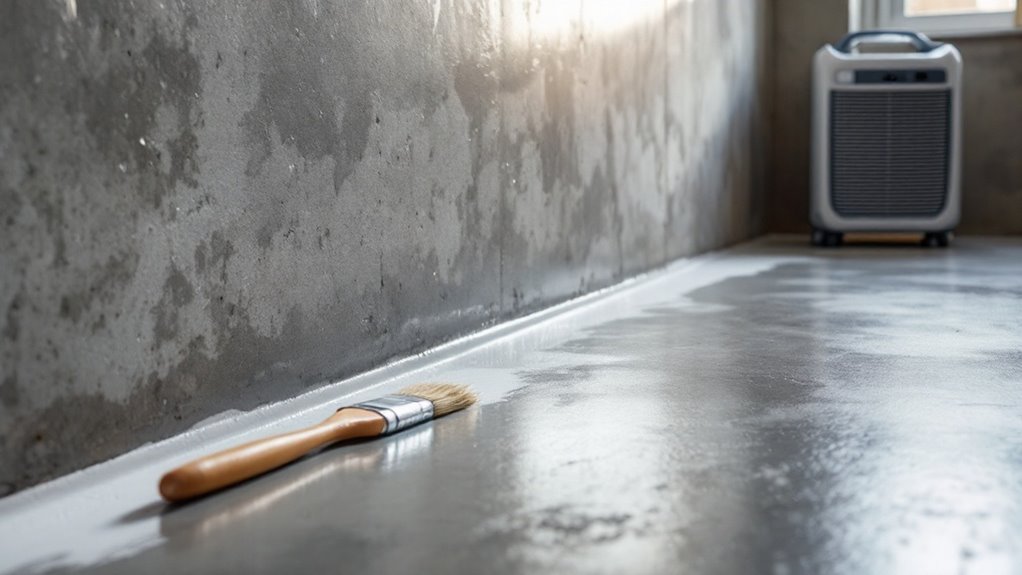
When it comes to basement waterproofing, there are several basic methods you can use to prevent water damage effectively and affordably.
One of the cheapest options is waterproof paint, costing about $1–$2 per square foot. It provides a solid barrier against moisture.
Another method is crack injection, which fills gaps to stop water seepage. Waterproof sealants can also protect surfaces, offering a budget-friendly solution.
DIY drainage systems, like installing a french drain, can be cost-effective too.
Finally, sump pumps remove accumulated water, ensuring your basement stays dry, though they may require a higher initial investment. Additionally, investing in professional waterproofing systems can enhance the longevity of your waterproofing efforts and prevent future issues.
Interior vs. Exterior Solutions
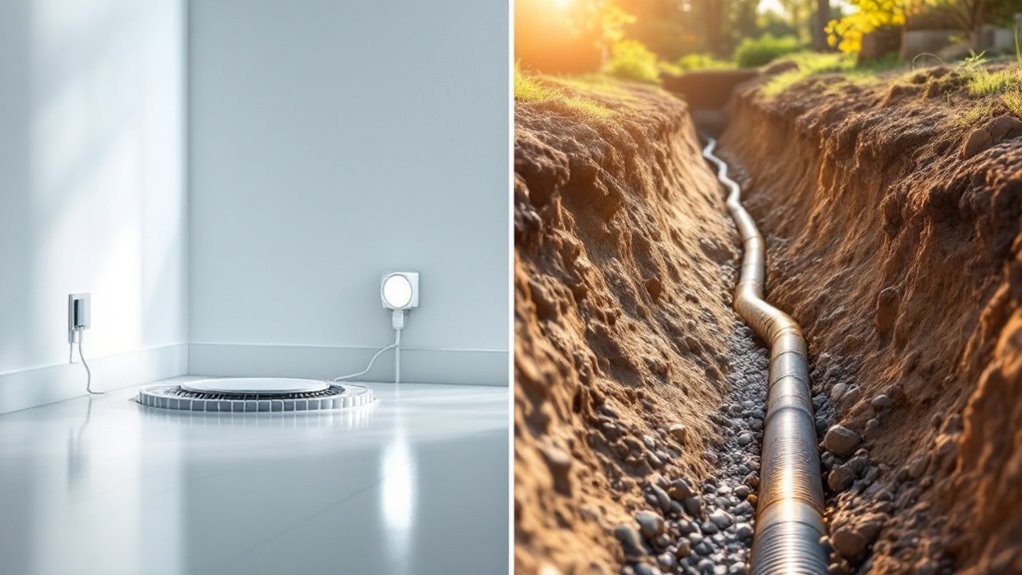
When choosing between interior and exterior waterproofing solutions, you’ll want to weigh costs, installation methods, and effectiveness.
Interior options, like waterproof paints and crack injections, can be affordable and easy to apply, but they may not address underlying issues.
On the other hand, exterior methods, such as gutter maintenance and sodium bentonite, often focus on preventing water from entering in the first place, which can save you money in the long run.
Cost Comparisons
While both interior and exterior basement waterproofing solutions aim to protect your home from water damage, they differ significantly in cost and effectiveness.
Interior options, like waterproof paint at $1-$2 per sq.ft. or epoxy sealants at $2-$3 per sq.ft., tend to be more budget-friendly. In contrast, exterior solutions often involve higher costs, such as French drains or foundation membranes.
- Protect your investment
- Enhance your home’s value
- Create a safe living space
- Avoid costly repairs
Understanding these cost differences helps you make informed decisions for your basement waterproofing needs.
Choose wisely to safeguard your home!
Basement Warning Signs?
Cracks, leaks, or musty smells could signal serious water damage ahead. Act now before minor issues become costly repairs.
- Class-A Licensed & Insured
- Full-Service Construction
- Trusted Local Family-Owned
Installation Differences
Understanding the installation differences between interior and exterior basement waterproofing solutions is essential for making the right choice for your home.
Interior methods require no excavation, allowing for quick installation—usually within 1-2 days—and rely on sump pumps to remove water. However, you’ll need to move belongings from walls during the process.
In contrast, exterior solutions demand full foundation excavation, applying waterproof coatings, and installing drainage systems. This approach can disrupt landscaping and takes longer due to the extensive work involved.
Knowing these differences helps you decide which method aligns best with your needs and circumstances.
Effectiveness Evaluation
Evaluating the effectiveness of interior versus exterior basement waterproofing solutions is essential for addressing your specific water issues.
- You want peace of mind in your home.
- Don’t let water ruin your living space.
- Protect your investment from costly damage.
- Choose a method that suits your unique needs.
Interior solutions, like waterproof paint and sump pumps, are great for minor dampness, while exterior options, like foundation grading and drainage improvements, tackle water at the source.
Ultimately, combining both approaches often yields the best results, ensuring your basement stays dry and safe year-round.
Cost-Effectiveness Factors
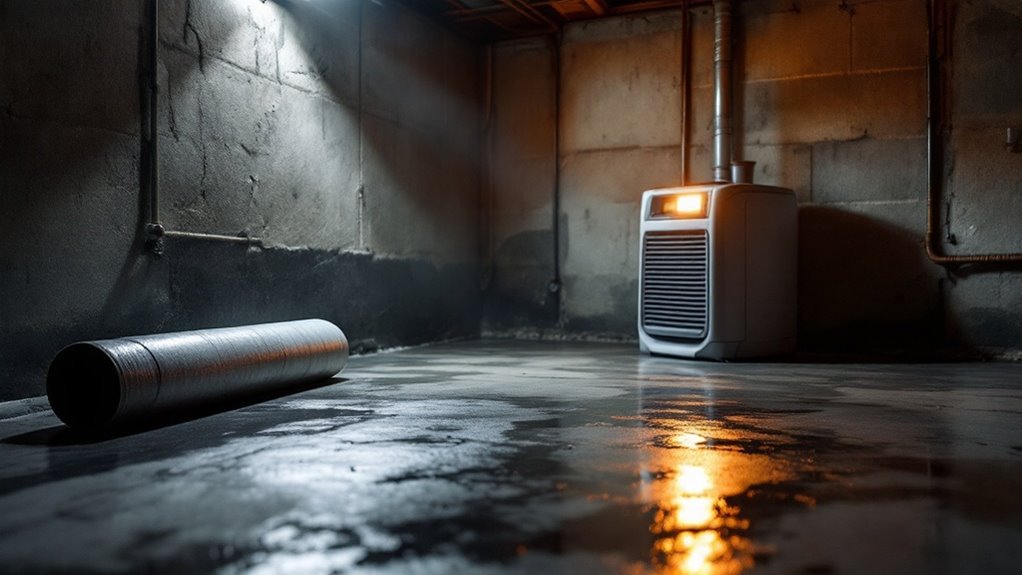
When considering cost-effectiveness in basement waterproofing, various factors come into play that can greatly influence your overall expenses.
Crack treatment strategies, like epoxy or polyurethane injections, offer effective sealing for small-to-medium cracks, preventing water infiltration without major foundation repairs. Their quick application means minimal downtime, making them a practical option.
Additionally, you can tackle exterior water management by cleaning gutters, extending downspouts, and improving landscaping to direct runoff away from your home.
These DIY-friendly measures can further reduce costs while enhancing your basement’s protection against moisture, making them smart choices for budget-conscious homeowners.
Sealant Types and Costs
When it comes to basement waterproofing, choosing the right sealant is essential.
You’ll find various options, like waterproof paint, which typically costs between $1 and $6 per square foot.
Comparing these sealants helps you determine the most cost-effective solution for your needs.
Types of Sealants
Selecting the right sealant for basement waterproofing can greatly impact the effectiveness of your project, especially when considering various options available.
Here are some common types you might consider:
- Paint-based sealants: Easy to apply with rollers, ideal for DIYers.
- Liquid sealants: Flexible and adaptable to surface conditions.
- Membrane sealants: Provide a long-lasting barrier; often require professional installation.
- Silicate-based sealants: Penetrate deeply to prevent moisture.
Choosing the right sealant can save you time, money, and future headaches, ensuring your basement remains dry and safe for years to come.
Cost Comparison
Finding the most cost-effective method for basement waterproofing can greatly impact your budget and long-term satisfaction.
The cheapest option is waterproof paint, particularly products like DRYLOK, which costs around $0.60 to $1 per square foot. Flex Seal follows closely at $1.20 to $1.50.
Interior sealing methods typically range from $200 to $3,000, making them more budget-friendly compared to exterior options, which can soar between $1,000 and $15,000.
If you’re considering DIY, opting for DRYLOK can save you even more.
Long-Term vs. Temporary Fixes
While you may be tempted to opt for quick fixes when dealing with basement water issues, understanding the differences between temporary and long-term solutions is essential.
Temporary fixes, like waterproof paint and gutter maintenance, can provide short-lived relief but often require frequent maintenance and reapplication. They may not address serious water problems effectively.
- You risk further damage down the line.
- A temporary fix might lead to costly repairs later.
- You’ll spend more time on upkeep instead of enjoying your space.
- Stress over recurring leaks can take a toll on your peace of mind.
Consider investing in long-term solutions for lasting protection.
Installation Complexity and Labor Costs
Understanding installation complexity and labor costs is essential when choosing a basement waterproofing method.
Waterproof paint and sealants offer the cheapest initial investment, costing $1–$6 per square foot, and can be applied easily with rollers or brushes after sealing cracks.
Waterproof paint and sealants provide an affordable solution, easily applied with rollers or brushes after crack sealing.
Gutter cleaning is a free DIY task but requires seasonal upkeep.
Downspout extensions, costing $100–$300, are manageable for most DIYers and help redirect water away from your foundation.
Crack injections range from $2–$5 per crack, typically requiring professional help.
Weigh these factors to find the most cost-effective and practical solution for your basement waterproofing needs.
So what did we learn?
In conclusion, choosing the cheapest basement waterproofing method often boils down to your specific needs and the condition of your space.
Did you know that nearly 60% of American homes have some form of moisture issue in their basements? By understanding the differences between interior and exterior solutions, as well as various sealant types, you can make an informed choice.
Remember, while low initial costs are appealing, consider long-term effectiveness to protect your investment.


